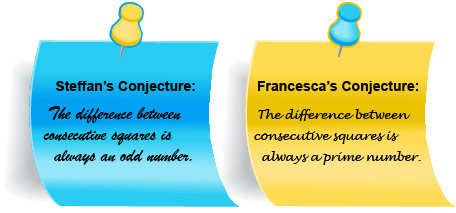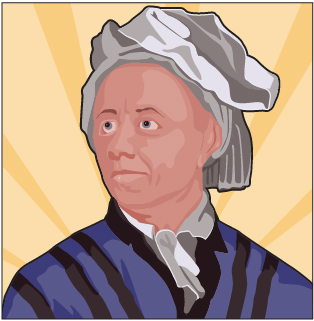Lesson 2
1. Lesson 2
1.3. Explore 3
Module 2: Logic and Geometry
Share 2
After investigating Steffan’s and Francesca’s personal strategies, discuss the following questions with your partner:
- How is it possible to have two different conjectures about the same situation?
- What strategies were used by Steffan and by Francesca to gather the evidence?
- What patterns did Steffan and Francesca find that they then used to develop their conjectures?
- Which conjecture do you prefer? Explain why.
Francesca and Steffan were both investigating the same situation, but the strategies they used to develop their conjectures were different. The common feature or property Steffan identified in his examples (i.e., odd numbers) was different than the common property Francesca found in her examples (i.e., prime numbers). So they ended up with two different conjectures about the same situation.

This example shows that it is possible to have different conjectures developed based on the following:
- method of observation
- samples or examples used
- interpretation of the evidence
Both Steffan and Francesca made general conclusions based on specific examples. Their conjectures were based on and supported by the specific examples they chose to use. So how can you determine whether their conjectures are reasonable or valid? Or how can you determine whether one conjecture is stronger than the other?
A conjecture can be strengthened by finding more examples that support it. The more support for a conjecture, the stronger or more reasonable the conjecture. Likewise, the selection of examples can affect the strength of a conjecture. Choosing only one type of example to support your conjecture limits the strength and reasonableness of the conjecture.
Did You Know?

iStockphoto/Thinkstock
The Clay Mathematics Institute of Cambridge, Massachusetts, established seven Millennium Prize Problems in the year 2000. The problems are based on conjectures made by mathematicians over the past few hundred years. The prize for solving one of these problems is US$1 million.
Dr. Grigoriy Perelman was awarded the first Clay Mathematics Institute Millennium Prize on March 18, 2010, for resolving the Poincaré conjecture. French mathematician Henri Poincaré developed the conjecture in 1904.
Want to take a shot at solving these problems and winning a million dollars? Type the keywords “CMI Millennium Prize” using your favourite Internet search engine.
Did You Know?

The great mathematician Leonhard Euler (1707–1783) made a conjecture based on a variation of Fermat’s Last Theorem. For over 200 years, the conjecture looked like it was true. Then, the conjecture was disproved. It failed on the number 61 917 364 224.
Mathematicians need to know that there will never be a counterexample to their conjecture. Just checking examples is never enough to prove a conjecture. For every example you check, there could be one that could fail the test.
Read “Example 2: Connecting to previous conjectures” on pages 19 and 20 of your Principles of Mathematics 11 textbook. As you read, consider whether
- more trials strengthen Steffan’s and Francesca’s conjectures
- it is possible to disprove a conjecture and, if so, what has to happen for a conjecture to be disproven
- more trials can prove a conjecture
More support for a conjecture developed through inductive reasoning will strengthen the conjecture but does not prove it. Even if a counterexample is not found, it does not mean that the conjecture is true. It is not possible to try all the possible cases, so it is not possible to prove a conjecture. On the other hand, one counterexample can disprove a conjecture. Once a counterexample has been found, the conjecture is invalid.
counterexample: an example that invalidates or shows a conjecture to be false
If it is easy to find a counterexample to a conjecture, then the conjecture is very weak. To strengthen the conjecture, it is important to test the conjecture to try to find counterexamples. Sometimes, a conjecture is made that seems obvious; but once you do a little testing, you quickly find a counterexample to disprove it. In this case, you may ask yourself, “Was I completely wrong? Is there any truth to my original conjecture?”